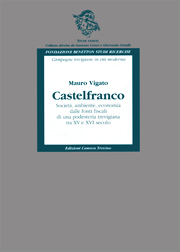
Castelfranco
Società, ambiente, economia dalle fonti fiscali di una podesteria trevigiana tra XV e XVI secolo
by Mauro Vigato
Fondazione Benetton Studi Ricerche-Canova
Treviso 2001
XVI-320 pages
5 illustrations black and white and an attached plate
euros 18
(series Studi veneti/Campagne trevigiane in età moderna, 9)
[Castelfranco. Society, environment and the economy seen through the fiscal documents of a podesteria in the Province of Treviso between the XV and XVI centuries]
At the end of the XVI century the podestà of Castelfranco described the town as a centre «full of fine houses» with borghi «benissimo casadi et populadi», inhabited by «citizens, merchants and artists».
Castelfranco straddled one of the most important lines of communication between Venice and the Germanic world. Its population grew steadily during the XVI century and the town achieved considerable expansion in its production and sale of worsted and silk. These developments brought about significant changes in the social fabric with the emergence of a wealthy, propertied elite which was well aware of the leading role it was called upon to play at the local level.
Shifting the focus outside Castelfranco itself, the pattern is one of a dense network of villages and an economy based almost entirely on agriculture. Other significant factors include the lithological and morphological features of an area lying between the lower and upper plains. With arid, gravely land in the north, fertile and well-irrigated in the central and southern parts the area featured a corresponding variety of environmental conditions and these also conditioned the strategies of both Castelfranco citizens and Venetian nobles, who had already invested heavily in land acquisition in the previous century.
Mauro Vigato graduated in history at the University of Venice. He has published several articles, including Gli estimi padovani tra XVI e XVII secolo [Tax assessments in Padua in the XVI and XVII centuries] («Società e Storia», 3, 1989) and the full-scale work Il monastero di Santa Maria delle Carceri, I comuni di Gazzo e Vighizzolo, la comunità atestina, a study of environmental change and socio-economic dynamics in an area to the south of Padua between the Middle Ages and the Modern Age (Carceri 1997).
Contents
Tavola delle abbreviazioni, p. VII; Nota archivistica, p. IX; Nota metrologica, p. XI; Elenco delle tabelle nel testo, p. XIII; Elenco delle tabelle in appendice, p. XV; Elenco delle tavole in appendice, p. XVI.
I. L’area: 1. La circoscrizione territoriale, p. 3; 2. La fondazione di Castelfranco e la nascita del capitanato castellano, p. 6; 3. La conquista veneziana, p. 16.
II. La società: 1. Evoluzione demografica e status sociale a Castelfranco tra XV e XVI secolo, p. 25; 2. Le trasformazioni istituzionali, p. 48.
III. Il paesaggio e l’ambiente: 1. I tratti geomorfologici e l’assetto idrografico, p. 69; 2. La vegetazione, p. 79; 3. L’assetto fondiario, p. 85; 4. Le tipologie colturali, p. 89; 5. Il tracciato viario e gli insediamenti, p. 103.
IV. Estimi e regime fondiario: la proprietà, la rendita, la stima: 1. Estimi “generali” ed estimi “particolari”: un’introduzione, p. 115; 2. L’estimo “particolare” del 1490-1493, p. 130; 3. L’estimo “particolare” del 1505, p. 143; 4. L’estimo del 1542-1555, p. 154; 5. Alcune considerazioni, p. 178.
V. Le conduzioni, i conduttori, le colture: 1. Le forme della conduzione, p. 181; 2. Gli obblighi contrattuali, p. 189; 3. I conduttori e le aziende, p. 196; 4. Le colture, p. 204.
Appendice, p. 217; Tabelle, p. 219; Tavole, p. 272; Glossario toponomastico, p. 277.
Bibliografia citata, p. 281; Indice dei nomi e dei luoghi, p. 89
